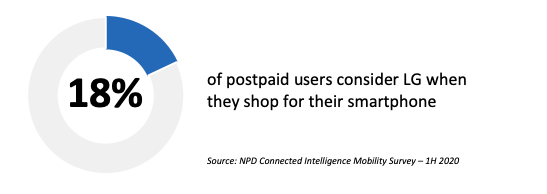
The Motorola razr goes 5G
Motorola last week introduced the upgrade to its iconic razr foldable smartphone, which was initially introduced as a Verizon-exclusive device back in December 2019. The foldable phone has received noticeable design and specification upgrades, but none are as noteworthy as its ability to run on 5G networks. The new phone runs on Qualcomm’s Snapdragon 765G platform and supports the sub-6 MHz 5G networks available through AT&T and T-Mobile. In fact, the striking part of the announcement is Motorola’s partnership with these carriers, which have longed ignored the Motorola smartphones for their postpaid lineups (aside from the low-end Moto e sold through T-Mobile). The razr’s other upgraded features include a larger (and much more functional) external display that runs simplified versions of select Android apps, a thinner bottom chin that replaced the older one that housed a fingerprint sensor (which is now located at the back of the panel). The new razr has also improved its image capturing; the older 16MP camera lens is replaced with a newer version that supports 48MP resolution, while the selfie camera upgraded from 5MP to 16MP. The new razr will commercially debut for $1400 “some time” in Fall 2020 as Motorola did not provide any specific dates. The phone will sell through AT&T and T-Mobile as well as through the prominent unlocked channels (Amazon and Best Buy).
The NPD Take:
- The new razr will not be available through Verizon, Motorola’s original distribution partner for the initial razr, as the phone does not support Verizon’s mmWave 5G technology, which requires additional antennas (which did not fit in the razr’s ultra-slim form factor). This absence would have (negative) derivative impacts on Motorola’s other products such as the 5G-powered Motorola Edge, another Verizon exclusive device as Verizon will not have the same motivation to push the brand as it did during the initial razr exclusivity.
- Motorola had an unfortunate launch with the initial razr due to the timing that coincided with COVID-19. The OEM had a major supply issue at a time when demand was also scarce for premium products due to economic uncertainties. The new razr should be relatively better considering the wider distribution (through AT&T and T-Mobile) and muted demand from the first half of the year.
LG Velvet debuts through T-Mobile
T-Mobile last week added LG’s Velvet smartphone to its 5G device lineup. The Velvet is not a new smartphone as it has been out in the market since mid-summer through AT&T and Verizon. The fact that T-Mobile’s version had a later debut data is not noteworthy either. What is striking, however, is LG’s maneuver in replacing the standard Velvet’s Qualcomm Snapdragon 765G chipset (which also powers the aforementioned new Motorola razr) with a 5G solution provided by MediaTek (the MediaTek Dimensity 1000C), which is rare to find in the upper mid-tier and flagship smartphones. The 5G-powered new Velvet is now available through T-Mobile’s retail and online outlets with an MSRP of $588 (or $24.50/month for 24 months). Notably, rival AT&T has a $599 price tag on the same phone (powered by the Snapdragon 765G), while Verizon offers its mmWave version at an MSRP of $699.
The NPD Take:
- LG/T-Mobile’s decision to replace the Qualcomm chipsets with a MediaTek one can be explained by a cost-reduction motivation as MediaTek’s silicons are generally cheaper than those offered by Qualcomm. On the other hand, the carrier’s MSRP on the phone is almost on par with that of AT&T.
- LG has long been a strong partner for T-Mobile’s prepaid and low-end postpaid device lineups. The OEM’s previous G series flagships had limited success, but the Velvet is poised to be a strong contender in the upper mid-tier space. Nevertheless, it’s noteworthy to mention that it took rival Verizon less than two months to drop the monthly EIP fee from $20/month to $10/month, thus LG’s performance in the top tier space is still debatable.